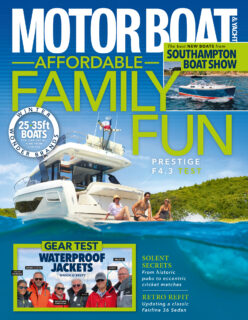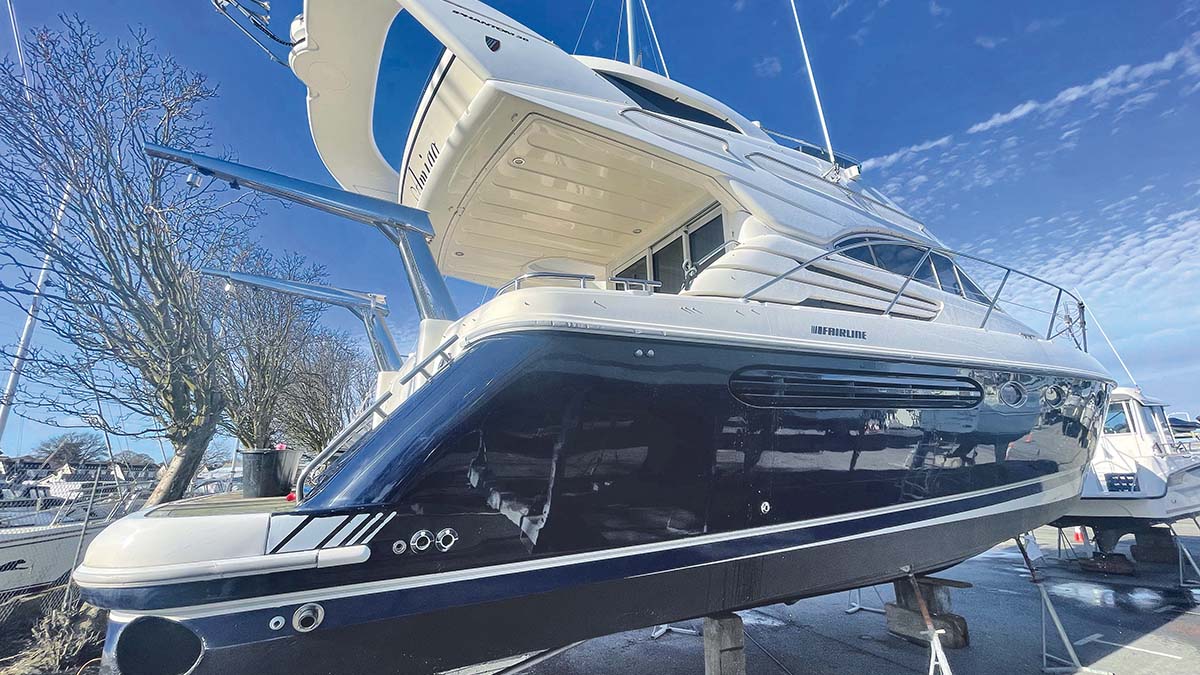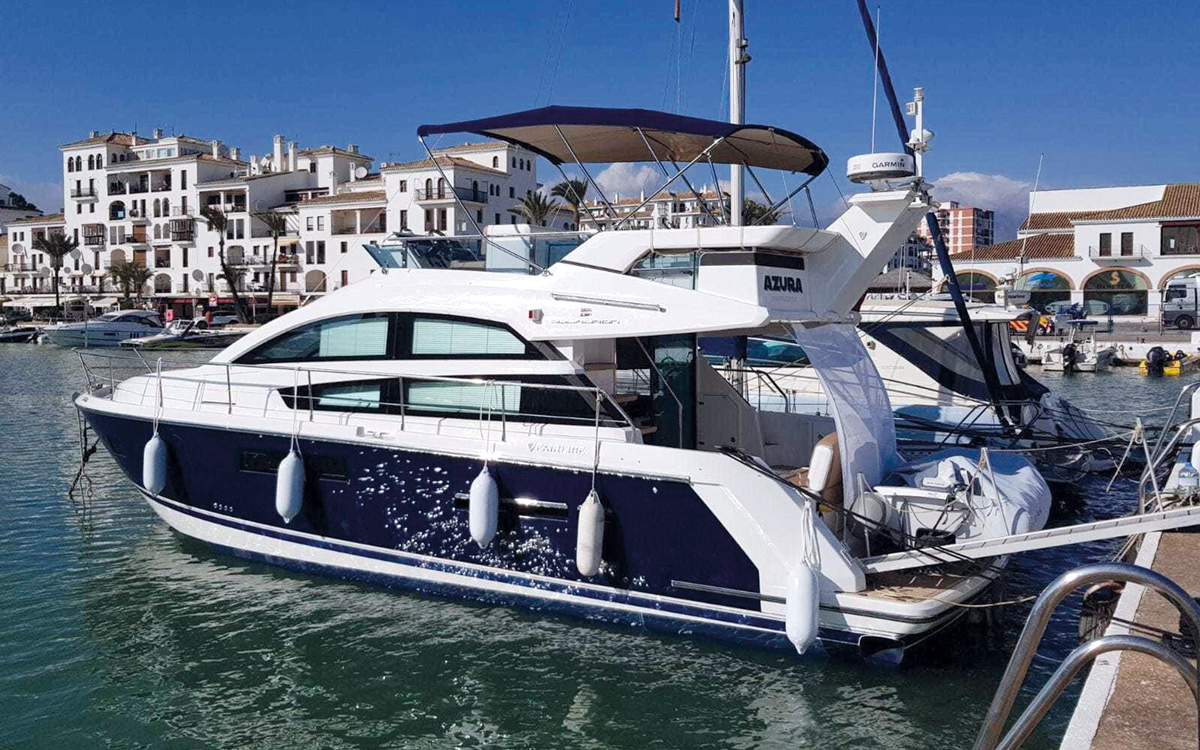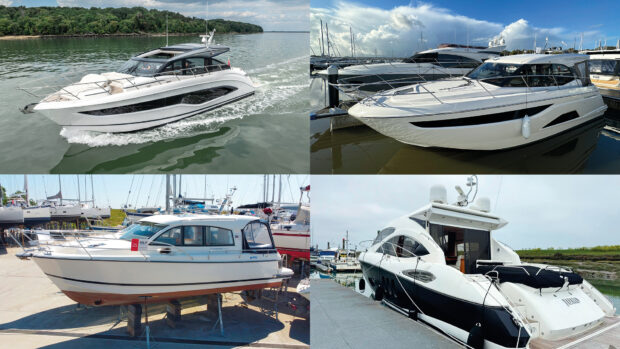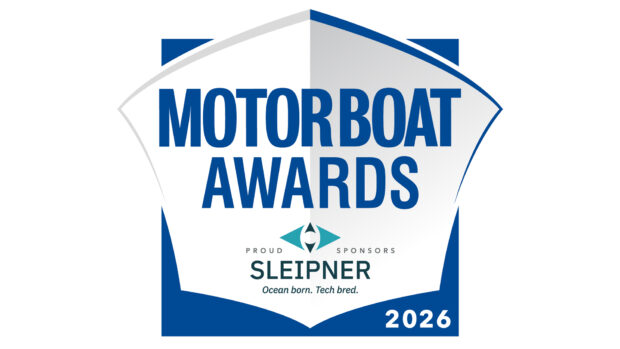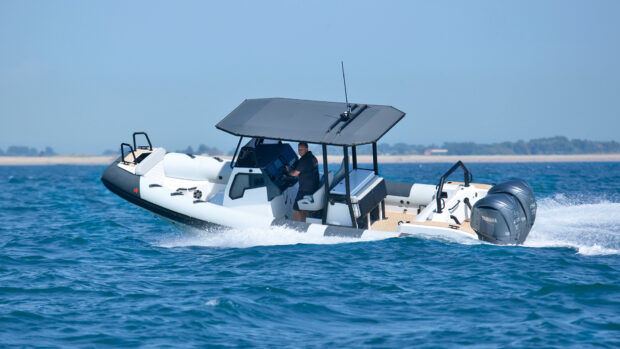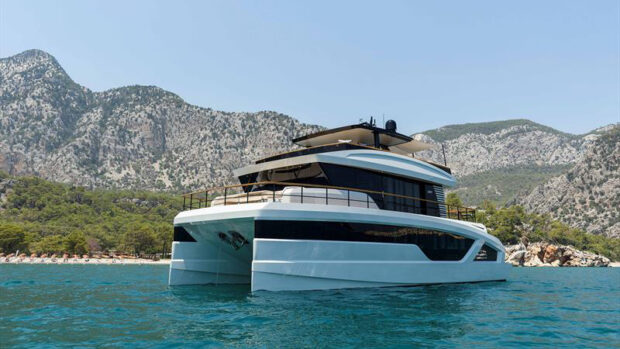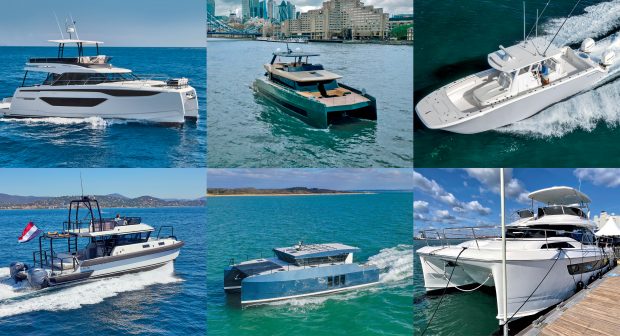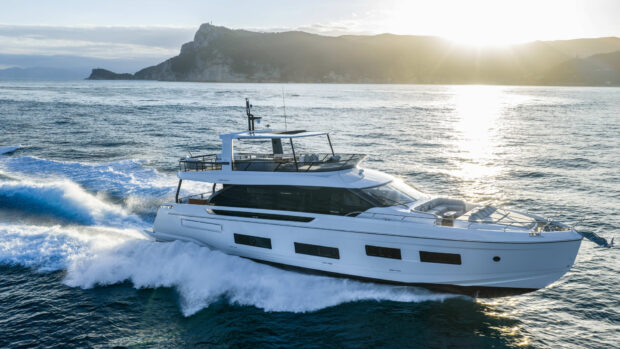Our resident used boat expert Nick Burnham picks out four of the best 40ft flybridges that can be found on the secondhand market…
Flybridge boats tend to have the reputation of being the Volvo estates of the motor boat world. Sure, you can see how practical they are and how much sense they make, but they’re for older people surely? The pipe and slippers option.
And then, possibly just like that Volvo estate or those slippers, quite unexpectedly one day you find yourself with a strange yearning. Yes, in your head you’re Don Johnson in Miami Vice at the helm of your sleek fast sportscruiser.
But it’s winter, your head is cold and you’re not looking forward to doing battle with the canopies upon your return to the marina. For me the road to Damascus moment was a sudden one. There I was, aimlessly browsing the MBY brokerage ads when an immaculate looking Princess 38 sprang at me from the pages and ambushed me.
Before I could help myself I was ruminating that my head would stay warm conning that from the lower helm and all hope was lost. And it turns out there are plenty of other desirable flybridges under 40ft too. Pass the slippers.
4 of the best 40ft flybridges for sale

Princess 38
Built: 2002
Price: £149,000
Many years ago, when I was a broker for Princess Yachts, I sold several of these to always satisfied owners. Launched in 1999, at the time it was the smallest boat in the range (indeed the marque’s flybridge range now starts at 45ft) and whenever a 38 owner visited a boat show I was at, I’d always take them aboard a much larger model.
The reaction was always the same: “It’s exactly like my boat, only larger.” And that was the key to this brilliant little compact cruiser, no sense that you were buying a cheaper Princess, only that you were buying a smaller one.
Interior
That sense of high-end quality begins the moment you step through the saloon doors. Indeed it begins with the saloon doors because, rather than the usual white powder coated aluminium finish, the three part sliding doors are framed with stainless steel, just as you’d expect from a seven figure 70-footer.
And so it continues – the high gloss cherry cabinetry might feel a little dated by today’s standards but there’s no criticising the quality, which is the equal of far larger models.
Most Princess 38s got a small double settee opposite the large C-shaped main settee to starboard, this one is rare in having been specced with a useful sideboard instead. On the lower deck the two cabins share one large heads rather than getting one each.

Forward owner’s cabin and guest cabin share the one heads between them
Exterior
The flybridge helm position consists of two bucket seats, but it’s impossible to access the navigation seat without displacing the helmsman. Other than that small quirk it’s a great layout with steps to the flybridge rather than a ladder and a decent sized bathing platform.
Performance
Princess offered twin Volvo Penta KAMD44 260hp diesel engines when new, but almost all went out with a pair of the larger TAMD 63 motors, either in 318hp or 370hp variant. This boat has the former, which should offer close to 30 knots.

Gloss cherry woodwork may look dated but there’s no doubting the quality of it
Seakeeping
The hull extends beneath the bathing platform increasing waterline length, a common trick now as it increases buoyancy aft and lengthens the waterline to improve the ride and the running angle.
Specifications
LOA: 39ft 10in (12.1m)
Beam: 12ft 59in (3.9m)
Draft: 3ft 1in (0.9m)
Displacement: 8.5 tonnes
Fuel capacity: 1,000 litres
Engines: Twin Volvo Penta TAMD 63L 318hp diesels
Location: Swanwick
Contact: Princess Motor Yacht Sales
Article continues below…

Secondhand boat buying guide: four 40ft flybridge yachts reviewed
A 40ft flybridge is a great cruiser with enough space and clever layout. We review four secondhand boats on the

Best boats around £150k: Our pick of the secondhand market
Fairline Phantom 38
Built: 1997
Price: £119,950
It’s impossible, or at least unwise, to look at any Nineties or early- Noughties Princess without checking out the Fairline alternative (or vice versa), so closely do the two product ranges mirror each other during this era.
In this instance, the Princess 38’s doppelgänger was the Fairline Phantom 38, although the Phantom came first; it was launched two years earlier in 1997, terminating in 2003 (as did the Princess 38).
Interior
The basic concept might be nigh-on identical, but the execution differed markedly in a couple of key areas. Although the basic set-up was the tried and tested owner’s cabin in the bow, guest cabin to starboard, galley to port and then a saloon on the main deck, the crucial difference was that Fairline managed to squeeze in a tiny second heads, meaning both cabins had their own facilities rather than needing to share (unless you wanted a shower, the second heads was too small to offer one of those).
The rest of the lower deck is a mite squeezed as a result, but if you have regular guests aboard it’s a lovely feature. Fairline also offered a light maple finish, although this boat sports the cherry wood.

An interior refit would lift the rather dated look of this blue-heavy interior
Exterior
The exterior follows the same pattern, conceptually similar but differing in the details. Thick styling mouldings did a great job of blocking much of the view from the lower saloon windows (amusing to note that the saloon images in the brochure have the blinds drawn) although the larger upper windows offer a great view.
And the flybridge layout is superior, with a central helm flanked by two further seats and more seating aft.
Performance
Fairline eschewed the smaller Volvo Pentas, offering both versions of the twin 63 lumps plus a 355hp Caterpillar option. This boat has the largest TAMD 63P motors which would have given a solid 30 knots when new.

The interior looks notably more modern than the earlier Princess and Fairline 38s
Seakeeping
An Olesinski designed hull like the Princess, the Phantom’s shaft drive, rudders and tunnelled propellers are better suited to directional stability than agility, which is exactly what you want in a comfortable flybridge cruiser like this.
Specifications
LOA: 38ft 7in (11.7m)
Beam: 12ft 8in (3.8m)
Draft: 3ft 3in (1.0m)
Displacement: 9.8 tonnes
Fuel capacity: 910 litres
Engines: Twin Volvo Penta TAMD 63P 370hp diesel engines
Location: Poole
Contact: Salterns Brokerage

Rodman 38
Built: 2002
Price: £119,950
Perhaps it’s the swage line bisecting the hull topsides, something Princess and Fairline had been fading out since the mid- Nineties, perhaps it’s the beige tint to the gelcoat, but the Spanish built Rodman 38 looks a little dated compared to the similarly sized and styled Princess 38 and Fairline Phantom 38.
Which is interesting because the Rodman 38 is actually a newer design, hitting the water in 2002 and running through to 2009. Most likely this is due to the builder’s roots. With a rich back catalogue of serious commercial vessels, its leisure craft tend to be a little more prosaic, but are absolutely rock solid.
Interior
Despite arguably lacking the nth degree of sophistication of its British rivals, there are some nice details in elements like the polished wooden trim in the ceiling, whilst the wooden floor provides a more practical, if less glamorous surface. The layout is again broadly similar, with Rodman emulating the two cabin, two head layout of the Fairline.

Like the Fairline, the Rodman has two heads as well as two cabins below decks
Exterior
Look more closely at the outside of this boat and you’ll realise that it is, in fact, more modern than it first appears. Witness the one-piece windscreen, rather than the two panes and central mullion of the other boats here, and the glass transom door rather than the old-fashioned solid GRP offering.
Rodman’s practicality shines through in the number of grab handles around the exterior and the seven-inch wide side decks. It’s a boat designed to be used.
Performance
Although launched with the traditional twin Volvo Penta KAD44 or TAMD63 P engines of its rivals plus a Yanmar diesel alternative, all connected to a shaft drive, Rodman later offered a Volvo Penta IPS500 option.
A very enthusiastic adopter of Volvo Penta’s pod drives from day one, this is a rare option in a boat of this size, style and vintage. This particular example has the twin TAMD 63P engines, the same as the boat we tested upon launch, finding 31 knots at the top end.

The interior looks notably more modern than the earlier Princess and Fairline 38s
Seakeeping
As solid as the rest of the boat, seakeeping is reassuring rather than exciting, again in keeping with expectations.
Specifications
LOA: 37ft 9in (11.5m)
Beam: 12ft 9in (3.9m)
Draft: 2ft 9in (0.9m)
Displacement: 8.0 tonnes
Fuel capacity: 940 litres
Engines: Twin Volvo Penta TAMD 63P 370hp diesel engines
Location: Essex
Contact: Boats.co.uk
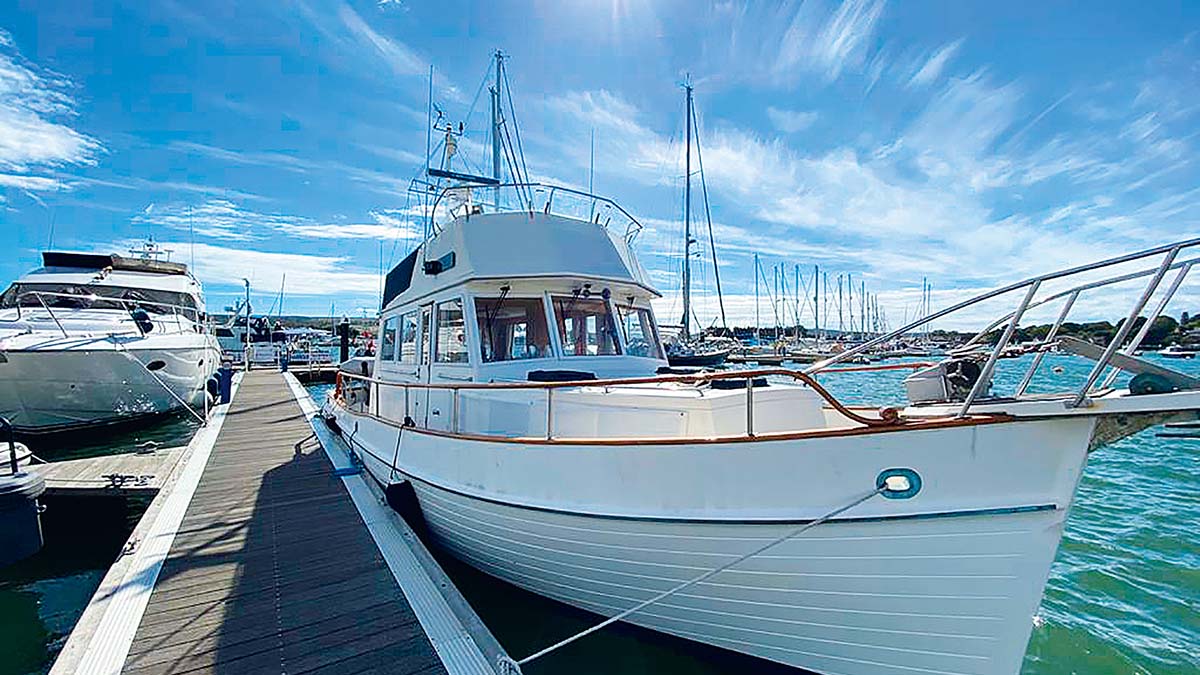
Grand Banks 36 Sedan
Built: 1991
Price: £139,950
Looking at the three boats preceding this one, you might be forgiven for thinking that there’s only one basic layout for a sub-40ft flybridge boat, but Grand Banks is here to prove that theory wrong.
Known for its aft cabin trawler yacht vessels (the Classic range), Grand Banks also made some fine aft cockpit flybridge variants under the Sedan or Europa banner.
Interior
Not content with offering three variations of the 36 hull, Grand Banks also offered two interior layout options for its Classic and Europa models.
Both shared the same main deck layout – a comfortable saloon accessed through a sliding door in the aft bulkhead (there’s another next to the helm) with settees on either side, a galley forward to port and the helm to starboard. The standard layout then had a vee-berth in the bow on the lower deck and a bunk bed cabin to port opposite the heads.
However, this is the Master Cabin layout which loses the second cabin in favour of a much larger owner’s cabin, putting the heads and shower in separate cubicles. For a cruising couple with only occasional guests (the saloon settees convert to beds), this is a terrific layout.

Master Cabin layout has just the one cabin but it’s a pleasingly big and comfortable one
Exterior
Very trawler yacht on the outside, you’ve got your low, wide side decks, raised bulwarks and a traditional ladder to the flybridge. It’s an easy boat both to board and to crew.
The hull itself is based on a design that dates back to the days when Grand Banks were building boats out of wood, hence the simulated planking of the GRP topsides.
Performance
Various engine options were offered, covering a wide spread of power, as some customers were content to cruise at displacement speeds, for which a pair of 135hp motors were adequate, while others craved semi-planing performance.
This boat has a pair of Cummins 210hp units, similar to the Perkins 225hp engines that powered our test boat to about 15 knots.

Much like the exterior, the GB36’s interior has a timeless appeal and lasting quality
Seakeeping
A semi-displacement hull, the Grand Banks pushes stolidly through heavy seas rather than bouncing over them at speed as a planing hull does. The result is plenty of spray but a calmer ride.
Specifications
LOA: 40ft 2in (12.3m)
Beam: 12ft 6in (3.9m)
Draft: 4ft 0in (1.2m)
Displacement: 12.5 tonnes
Fuel capacity: 775 litres
Engines: Twin Cummins 210hp diesel engines
Location: Port Solent
For sale: Boat Showrooms
First published in the July 2023 issue of MBY.
4 more 40ft flybridges from the May 2021 issue

Princess 388
Built: 1991
Price: £79,950
One of the first Bernard Olesinski designs for Princess Yachts, it replaced the John Bennett-designed 385. Although a similar concept, a complete change of style meant it looked like a boat from the future.
Interior
The layout of the 388 mirrored its 385 predecessor and the 38 that set the template before that. It’s a set-up that just works – a central double berth in an ensuite owner’s cabin forward, a guest cabin with twin singles to starboard, and opposite that the day heads and galley.
Steps lead up from there to the saloon on the main deck. The raised double helm seat is to starboard with an L-shaped dinette aft of it and a straight settee opposite helping to create a sociable seating area.

Galley is on the lower deck with an owner’s cabin forward and a twin guest to starboard
Exterior
The outside was broadly similar in concept to the 385 but the big news was the lower deck portholes. Previously positioned in the coachroof, for the 388 they’d shifted down and were now part of the hull, the biggest change to glazing until large hull windows began to appear 20 years later.
A double knuckle in the hull visually broke up the topsides and the superstructure looked more rakish. No sign of transom doors or flybridge stairs yet, however, just the usual ladder.
Performance
Almost all Princess 388s went out with a pair of Volvo Penta TAMD 61 306hp straight six diesel engines nestled beneath the saloon floor. Connected straight to shaft drive, these old-school mechanical motors, complete with cable operated controls, are simple, well proven and pushed the boat toward 30 knots when it was new.

The raised helm and sociable saloon layout works as well today as it did 30 years ago
Seakeeping
The first boat Olesinski designed for Princess was the 45, a boat renowned to this day for rewriting the abilities of the modern planing flybridge cruiser. (Maximum geek points for knowing that the 30DS was the first Olesinski designed Princess but it was an existing concept he took to them.) The Princess 388 was Princess 45 lite – solid, capable and able to maintain high speeds when the sea was up.
Specification
LOA: 38ft 8in (11.8m)
Beam: 13ft 6in (4.1m)
Draught: 3ft 0in (0.9m)
Displacement: 8 tonnes
Fuel capacity: 1,137 litres
Engines: Twin Volvo Penta TAMD 61 306hp diesel engines
Location: Plymouth
Contact: Red Ensign
Sealine 42/5
Built: 2010
Price: £219,950
When Sealine launched the 42/5 at the Southampton Boat Show in 2001, the clue was in the name. Sealine’s SECS (Sealine Extending Cockpit System) turned the boat from a 42-footer to a 45-footer, with those extra three feet all added to the cockpit, at the push of a button.
Interior
But there is far more to the 42/5 than just the ability to change length depending on whether the marina has its tape measure out. The layout is classic 40ft flybridge, with a twist. The standard layout, which this boat has, is ensuite master cabin forward, guest cabin to starboard, galley to port then steps up to the saloon.
The twist was an alternative layout that moved the galley up to the port side of the saloon, leaving space for a third cabin on the lower deck. There was also a version of the second cabin that allowed it to convert to a small office. Post 2006 boats (like this one) got an interior refresh that included more contemporary carpentry and seating.

Forward owner’s cabin is a decent size and has plenty of storage for clothes
Exterior
Living up to its innovator billing, as well as the SECS system, Sealine gave the 42/5 the option of a cockpit barbecue and a crane to lift the tender aboard, while integrated anchor stowage in the bow was standard.
The cockpit is well protected by a long flybridge overhang, which itself creates space for sunpads at its aft end that integrate with the seating by folding the backrests flat.
Performance
Volvo Penta’s TAMD series engines were the popular choice when this boat was launched – either twin TAMD 63P at 370hp each or TAMD 74 or 75 motors at 430hp or 480hp.
Cummins were also an option, although rare in Europe, as most Cummins boats went to the USA. After 2005 the new D Series Volvos were fitted, this boat getting twin D6-435 435hp motors for a top speed close to 30 knots.

Lower galley still feels connected to the saloon in this two cabin version of the boat
Seakeeping
A shaft drive puts the engines toward the centre for safe predictable seakeeping.
Specification
LOA: 42ft 4in (12.9m)
Beam: 13ft 0in (4.2m)
Draught: 3ft 3in (1.0m)
Displacement: 11.8 tonnes
Fuel capacity: 1,410 litres
Engines: Twin Volvo Penta D6 435hp engines
Location: Weymouth
Contact: J D Yachts
Fairline Squadron 42
Built: 2012
Price: £324,950
Launched in 2010, the Squadron 42 is an object lesson in just how far boat design had evolved since the 1990s. Although the same basic layout, the look and the feel are dramatically different from earlier boats of this size.
Interior
Pale woods were very much in vogue when this model launched, but there’s something reassuringly classy about the darker satin walnut interior.
The layout remains the same as the older boats featured here, but there’s a sense of space engendered by both the crisp contemporary joinery and the amount of glazing throughout, particularly in the forward cabin where the centre section of the ceiling is almost all glass.

Long strip of overhead glazing makes for a lovely bright cabin when the sunpads are removed
Exterior
The glossy dark blue topsides really set this boat off. The superstructure is a little more angular and it’s a very contemporary looking vessel. One particularly neat feature is a cockpit seat that faces forward into the boat, so far so conventional.
But tilt the backrest forward and it becomes an aft-facing seat, transforming your view from saloon doors to, well, the world. Another clever touch is a tender- launching system that cantilevers a RIB from bathing platform to water.
Performance
Buyers could opt for Volvo Penta D6 series motors in either 370hp format, as fitted to this boat, or 435hp versions. Both were linked to conventional shafts and rudders.
We tested the boat with the latter and achieved 30 knots. The smaller engines would likely be a knot or three down on this, but should still give an easy 20-knot cruise.

Sharper design looks a lot more contemporary than the other boats featured here
Seakeeping
With around a 13° transom deadrise, this Fairline was one of the first to incorporate flatter aft sections to the hull. The idea was to create easier planing ability but with the hull sharpening to a deeper vee forward for good headwind ability.
We tested the boat in a blustery Force 5 and discovered the concept worked well, although the sheer weight of the boat (15 tonnes loaded) meant it could displace some spray!
Specification
LOA: 42ft 5in (12.9m)
Beam: 13ft 10in (4.2m)
Draught: 3ft 6in (1.1m)
Displacement: 15 tonnes
Fuel capacity: 996 litres
Engines: Volvo Penta D6-370 370hp diesel engines
Location: Spain
Contact: Boats.co.uk

Nord Star 40
Built: 2014
Price: £364,950
Sometimes it’s hard to pigeonhole boats to a specific category and the Nord Star 40 is a case in point. At first glance it looks like a walk-around wheelhouse cruiser like a Botnia or a Sargo (both built in Finland, as this boat is).
But the crucial difference, and the reason for its inclusion in this feature, is that the Nord Star incorporates a proper flybridge deck as an option.
Interior
The interior of the boat is typically Scandinavian – extremely practical but saved from being utilitarian by a high standard of finish. The two side doors are augmented by another sliding door in the rear bulkhead, improving both access and ventilation.
Helm and navigator get individual and very comfortable-looking seats to port and starboard, and there’s a decent saloon area behind them as well as a galley aft.

Two sets of steps lead down to the owner’s cabin forward and the guest cabin aft
Drop down to the lower deck forward and you’ll find a double berth in the forward cabin and there’s a heads down here as well. Less obvious is the discovery that further aft is a separate access behind the dinette which leads down to another cabin with a double berth and its own heads.
Exterior
The outside of the boat is pure walk-around at deck level. Wide, safe, well bulwarked and teak-laid walkways either side of the wheelhouse take you forward to the foredeck or aft to the cockpit.
But what is unusual are the steps leading up to a surprisingly large flybridge situated over the wheelhouse. Until fairly recently Nord Star was the only manufacturer offering this on a walk-around style 40 footer.

Busy wheelhouse design has sliding aft doors to the cockpit and side doors to the decks
Performance
A pair of Volvo Penta D6-370 diesels sit beneath the aft deck. They transmit their combined 740hp through a pair of duo prop outdrives which push the boat close to 40 knots, making a fast 30-knot cruise possible.
Seakeeping
Those outdrives don’t just offer a relatively slippery low drag, high-speed solution, they also give fast and direct handling as direction changes are via vectored propeller thrust rather than the more passive water deflection of rudders.
And it’s Finnish, so expect a sturdily built but soft riding hull that’s more than capable of taking on choppy seas.
Specification
LOA: 42ft 7in (13.0m)
Beam: 12ft 8in (3.8m)
Draught: 3ft 3in (1.0m)
Displacement: 10 tonnes
Fuel capacity: 860 litres
Engines: Twin Volvo Penta D6-370 370hp diesels
Location: Southampton
Contact: Approved Boats
First published in the May 2021 issue of Motor Boat & Yachting.
If you enjoyed this…
Be first to all the latest boats, gadgets, cruising ideas, buying advice and readers’ adventures with a subscription to Motor Boat & Yachting. Available in both print and digital formats, our monthly magazine will be sent directly to your home or device at a substantial discount to the usual cover price. See our latest offers and save at least 30% off the cover price.
